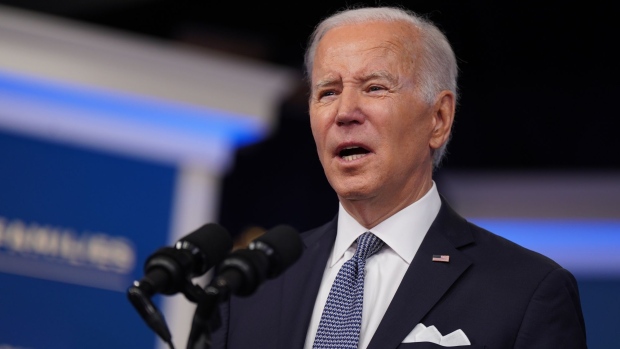Jan 30, 2023
White House to End Covid-19 Emergency Declarations On May 11
, Bloomberg News

(Bloomberg) -- The White House will end a pair of Covid-19 emergency declarations on May 11, spelling the elimination of the controversial Title 42 restrictions and expulsion measures at the US-Mexico border.
The Covid-19 national emergency and public health emergency will be extended to that date and then lifted, the administration said Monday in a statement of policy on bills related to the measures.
The step is a milestone in a coronavirus response that dominated much of the early weeks of President Joe Biden’s administration. The White House released the statement of administration policy in response to a pair of measures proposed by Republicans in the House of Representatives that would terminate the emergencies.
It also will mean the end of Title 42, a border policy that expanded expulsion powers based on the emergency declaration. The measure will end on May 11 when the emergency underpinning it expires, an administration official said in a written statement.
The US pandemic response has gradually shifted to the background, even as uptake of the latest booster shot remains modest. About 500 people are dying each day from Covid, Centers for Disease Control and Prevention data show.
At the same time, the World Health Organization said earlier on Monday that the global health emergency declaration remains in place. The decision by the United Nations agency was made after a meeting held by the Covid-19 emergency committee on Friday. WHO Director-General Tedros Adhanom Ghebreyesus said he remains hopeful that the “world will transition to a new phase” in the coming year.
Title 42
Title 42 was invoked by the Trump administration in 2020 as a means to slow the spread of Covid-19, but then became a flashpoint. Many Republicans supported the public health powers as a de facto border measure, whereas immigration groups had pushed for it to be lifted.
Title 42 has been used more than 2 million times to expel migrants since the spring of 2020, according to government data. The Supreme Court ruled in December that it must remain in effect until the justices hear arguments on whether to lift it. The end of Title 42 is expected to coincide with an increase in border crossings and asylum claims.
The administration official confirmed that the measure would be lifted when the public health emergency ends on the planned date of May 11. The administration wants to end Title 42 in a safe and orderly way, the official said.
The measure sat at the crossroads of two of Washington’s most bitterly debated subjects: pandemic restrictions and the border. Biden made his first visit as president to the border on Jan. 8, surveying security measures and a fence while not interacting with any migrants.
The administration had said it would would enforce Title 42 while it waited for the outcome of the legal battle, but now is saying it will instead lift it in conjunction with ending the emergency. It’s not immediately clear what it means for the court case.
Repeated Extensions
On Jan. 11, the US Department of Health and Human Services extended the coronavirus public health emergency once more through mid-April, maintaining measures that have expanded access to health care for millions of Americans since the original declaration was made by the Trump administration in January 2020.
The Biden administration said in the Monday statement that it would extend the public health emergency even further — to May 11. The White House declined further comment. The Department of Health and Human Services didn’t immediately respond to a request for comment.
The Biden administration has promised to give states 60 days notice before ending the public health emergency to allow sufficient time to prepare for changes to programs and regulatory authorities. The emergency declaration allowed millions of Americans special access to Medicaid, the state and federal program that provides health coverage to low-income people, and also created flexible access to telehealth services.
The administration said it was providing advance notice as “an abrupt end to the emergency declarations would create wide-ranging chaos and uncertainty throughout the health care system.”
The public health emergency allowed Medicaid to keep patients continuously enrolled through the end of the special designation. As a result, Medicaid enrollment has increased significantly from pre-pandemic levels. Congress declared in its year-end spending bill an end to the continuous enrollment provision at the end of March. Kaiser Family Foundation estimates between 5 million and 14 million people could lose Medicaid coverage when the provision is dismantled.
Republican lawmakers have long demanded the Biden administration end the public health emergency, criticizing it as a heavy-handed form of government intervention. Health policy experts supporting the designation argued that the health department must ensure protections for vulnerable people before unwinding the emergency designation, especially during the winter, when the risk of coronavirus transmission rises and burdens the health system.
©2023 Bloomberg L.P.


